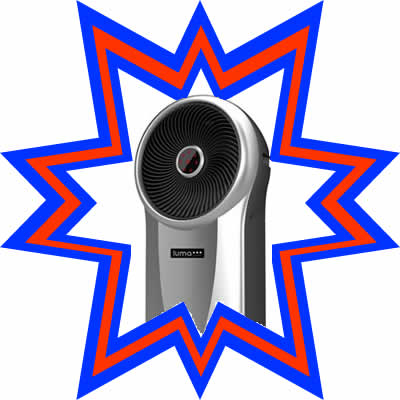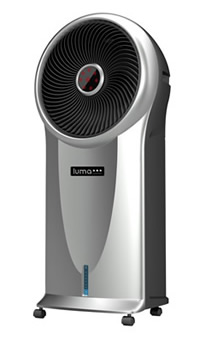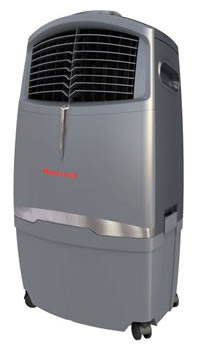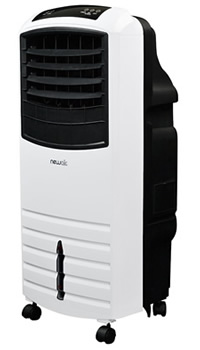Comparing the Best Evaporative Coolers
There are several top swamp coolers on sale right now that have attractive benefits so let's compare the best models to see which suits your needs and wants in an economical air cooling solution.
I'll be taking a look at several factors in this comparison article to make it easy for you to decide which model you want for your home, office or workplace.
 The main factors which will determine whether a cooling appliance is right for what you want it for are:
The main factors which will determine whether a cooling appliance is right for what you want it for are:
- Purchase cost
- Cooling capacity
- Power consumption
- Water reservoir size
- Ease of use (including controls and remote)
- Portability
- Additional features
These are the main deal breakers for most people so I'll be providing hard facts and manufacturer claims for each model in the comparison.
I'll also be including some additional information such as the unit's longevity, build quality and ease of assembly where appropriate. However this information can be somewhat subjective and not necessarily provably factual as individual units may not be representative of an entire product line.
Expanding on Each Factor
Let's take a moment to expand upon each factor that I'll be looking at (as listed above) so you'll get a better understanding of what each one can bring in terms of benefits to the owner. The tests on air cooling capacity and efficiency are what you should expect to get when used in ideal climate circumstances, which is very low humidity.
Purchase Cost
This is a pretty difficult one to actually nail down as the manufacturers put out a recommended retail price that stores should charge, but in reality many stores discount that price to get more customers to buy from them. So while the recommended price may seem a little high if you've already been doing some research of your own, you're bound to find a better price with a store discount.
That's because individual store prices will fluctuate depending on how much of a discount they're offering on the day of purchase. For this reason I can't publish hard prices because they'll be out of date by the time you read this article.
However, I have included a store widget from Amazon that does display their current price, which should give you a good starting point.
Cooling Capacity
This figure is made up of several factors that the manufacturer claims and is a fixed element that can be reported factually. These factors include the area of a room that can be effectively cooled, the unit's air flow capacity in cubic feet per minute (CFM) and the amount of temperature reduction it is capable of in ideal circumstances.
Power Consumption
This is another fixed element that can be factually reported according to the manufacturer's specifications for the model. It is the amount of electricity the unit consumes on its low setting in electrical units (Watts).
Water Reservoir Size
This is the capacity of the water tank that comes with the unit. It determines how much water can be placed in the machine to keep it running for a certain length of time before it needs refilling.
Some models have easier refilling than others and I'll be noting this too.
Ease of Use
This can be a little subjective, but is based on how easy the controls are to figure out and also if the remote is easy to use or not. It also covers whether the unit is suitable for use overnight in a bedroom or can be used outdoors.
Portability
Again, this can be a little subjective but is based on hard facts such as the unit's dry weight (without water) and size (overall dimensions stated as Height x Width x Depth in inches), the quality of its casters (wheels) and how easy it is to move around from room to room.
Additional Features
This will consist of any additional benefits can be had from owning a certain model such as whether it's tank can be hooked up to a garden hose for continuous running without manually refilling for example.
Which Models Compared Here?
I've simply taken some of the top selling models from a cross section of manufacturers and reported my findings here in an easy to read table.
 Luma Comfort EC110S |
 Honeywell CL30XC |
 Honeywell CS10XE |
 NewAir AF-1000W |
Cooling Capacity:
500 CFM
Power Consumption:110 Watts Water Reservoir Size:14 pints (1.76 gall) Ease of Use:Easy to use digital control panel plus remote Portability:
Weight: 16.2 lbs
Additional Features:Three cooling speeds and cyclonic wind modes, programmable 7.5 hour timer, removable water tank, air cleaning filter |
Cooling Capacity:
525 CFM
Power Consumption:252 Watts Water Reservoir Size:63 pints (7.9 gall) Ease of Use:Very easy electronic controls and full function remote Portability:
Weight: 24.9lbs
Additional Features:Top-loading ice compartment, detachable water tank, low water alarm, carbon dust filter for purer air, four fan speeds, oscillating louvers for even air distribution, adjustable humidification level |
Cooling Capacity:
300 CFM
Power Consumption:100 Watts Water Reservoir Size:21 pints (2.6 gall) Ease of Use:Easy controls with full function remote Portability:
Weight: 18.5 lbs
Additional Features:Carbon dust filter to cleanse the air, four fan speeds, oscillating louvers for better air distribution, detachable water tank and low water alarm, auto shut-off timer |
Cooling Capacity:
1000 CFM
Power Consumption:160 Watts Water Reservoir Size:42 pints (5.3 gall) Ease of Use:Easy to use digital on-board controls with remote Portability:
Weight: 23.4 lbs
Additional Features:Three fan speeds, oscillating for better air distribution, carbon air filter, 10 hour timer, three different color options |
How Much Power Does a Swamp Cooler Consume?
The power consumption of vent free, portable evaporative coolers varies from model to model, but in general you can expect medium size units to consume between 100-200 watts of electricity. The energy use is determined in the main by the size and power of the internal fan that drives the wind through the machine.
Larger machines that have greater cooling capacities will naturally use more electricity because they have bigger fans! However, you have to remember that even a high powered evaporative cooler still uses between 1/10th and 1/20th the amount of energy a comparable air conditioning unit will use to do the same job of keeping you cool.
That's a massive saving in energy costs especially when you add it up over a whole summer season. It almost makes it a tempting idea to move from a place that has a humid climate to one that has a dry climate to take advantage of the savings!
Well, maybe not, but you get the idea!

[Back to TOP]